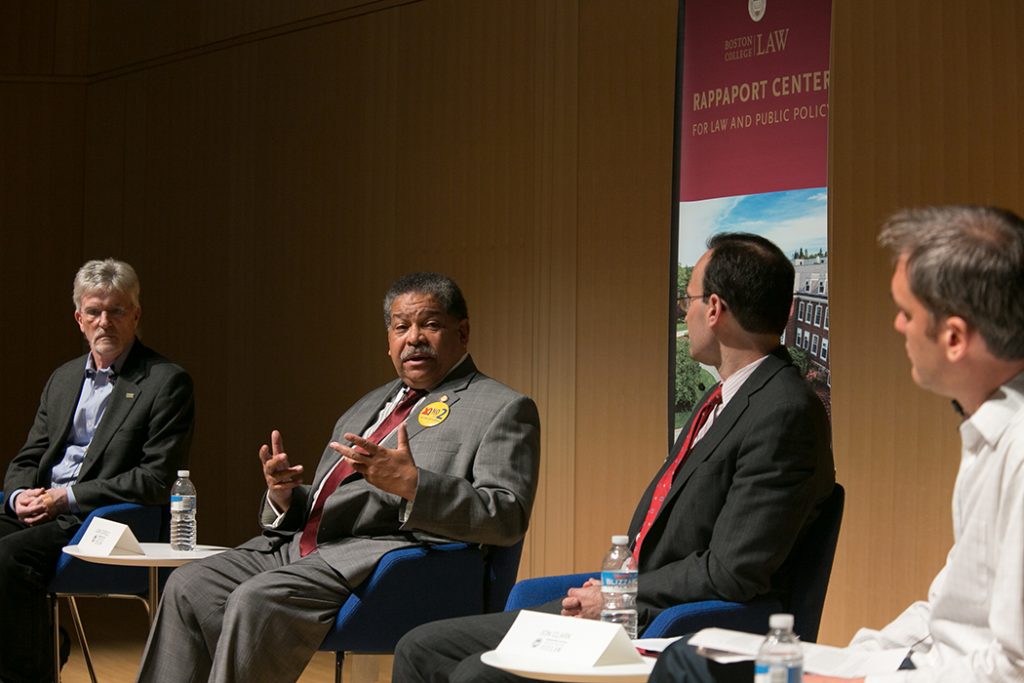The potential expansion of charter schools is a key issue for voters in Massachusetts this fall. If approved, the Question 2 referendum would give the Massachusetts Department of Elementary and Secondary Education the authority to allow up to 12 new charter schools or enrollment expansions of existing charters each year.
The issue was the topic of a recent panel discussion, “Charter Schools: Lift the Cap or Not?” sponsored by the BC Law Rappaport Center for Law and Public Policy. Moderated by David Scharfenberg of the Boston Globe, the event covered questions such as “Have we lost sight of the most important mission of charter schools?” “How will this impact public school funding?” and “What’s the plan to fix schools?”
The panel included Jon Clark, network co-director of Brooke Charter Schools; Juan Cofield, president of the New England Area Chapter of the NAACP, and Patrick McQuillan, professor at the Boston College Lynch School of Education.
The panelists agreed that charter schools were meant to serve a dual purpose: the Massachusetts Education Reform Act of 1993 opened the door for charter schools in the hopes they would both be laboratories for educational innovation and provide parents and students with greater educational options. Charter schools were given the authority and flexibility to experiment, implementing changes such as a longer school day. Legislatures envisioned that, through dialogue, public schools could adopt some of the best practices that emerged from the charter schools.
Both sides of the debate recognize the dialogue has broken down, but McQuillan said that school leaders can still learn from each other, citing as an example the Lynch Leadership Academy, which brings together leaders from Catholic, charter, and district schools to facilitate the exchange of ideas.
While charter schools provide greater educational options for families, Cofield saw the need to improve all schools, not to establish and fund a parallel educational system of charter schools. Clark argued that charter schools are not meant to be a second school system, but to create competition to force district schools to improve.
The panel also took on the controversial topic of funding. Critics contend that charter schools will drain $450 million from public schools, forcing municipalities to take money out of other parts of the budget. For example, Boston has diverted funding from public schools, a practice Mayor Walsh has called unsustainable. Other experts do not expect a drain on the public school system since “funding follows the student.” When a child enrolls in a charter school, the amount the district would normally spend to educate the student goes to the charter school.
Currently, 4 percent of Massachusetts students attend charter schools, and a proportionate 4 percent of Chapter 70 state funding goes to the charter schools. According to McQuillan, there will be a drain on the educational funding system, but it is difficult to gauge the degree. The drain on financing stems from the fact that districts cannot nimbly reduce their fixed costs, such as building maintenance and cafeteria costs. For example, a classroom’s light bill would be the same if there were 30 students or 15 students, he said. When students depart, the funds allocated to them, including the portion allotted to paying the light bill, move with them. Consequently, municipalities are forced to find the money for such costs elsewhere in their budgets.
Under current laws, no more than 120 charter schools may operate in the Commonwealth. A provision of the law limits local school district spending on charter schools to 9 percent, creating de facto caps on the district level. Urban school districts, including Boston and Worcester, where charter enrollment is high, would benefit from lifting the cap. There are currently 32,000 students on waiting lists for a spot at a charter school, many of them from low-income communities.
A point all panelists agreed on is that the question of raising the cap on charter schools should have been handled by the Legislature, citing the complexity of the issue. Clark cited political pressure and gridlock as reasons for why the Legislature has failed to take meaningful action.
The panelists also agreed that regardless of the outcome, the fundamental problem of struggling public schools will persist. Charter schools provide an opportunity to families in struggling districts and pressure for traditional district schools to do better. Still, other improvements can also be made, they said, counting among them parental involvement and a creating a culture that encourages principals and teachers and gives them autonomy to do what is best for their students.
Photo: Panelists, left to right, Patrick McQuillan, professor, BC Lynch School of Education; Juan Cofield, president, NAACP New England Area Conference; Jon Clark, network co-director, Brooke Charter Schools; and moderator David Scharfenberg, reporter, Boston Globe. Photograph by Reba Saldhana
Story by Amar Patel ’18


